Melatonin Prevents Early but Not Delayed Ventricular Fibrillation in the Experimental Porcine Model of Acute Ischemia
Abstract
1. Introduction
2. Results
2.1. Effects of Ischemia
2.2. Ventricular Fibrillation Incidence and Prediction
2.3. Evaluation of Heart Rate Dynamics
2.4. Melatonin Effects
3. Discussion
4. Materials and Methods
4.1. Animal Preparations and Experimental Protocol
4.2. Electrophysiological Data Recording and Processing
4.3. Oxidative Stress Assessment
4.4. Infarct Size Estimation
4.5. Statistical Analysis
5. Conclusions
Author Contributions
Funding
Institutional Review Board Statement
Data Availability Statement
Conflicts of Interest
Abbreviations
| IVS | Interventricular septum |
| LV | Left ventricle |
| AT | Activation time |
| RT | Repolarization time |
| DOR | Dispersion of repolarization |
| VF | Ventricular fibrillation |
| LAD | Left anterior descending coronary artery |
| VT/VF | Ventricular tachycardia and/or ventricular fibrillation |
| TAC | Total antioxidant capacity |
| SOD | Superoxide dismutase activity |
References
- Camm, A.J. Hopes and disappointments with antiarrhythmic drugs. Int. J. Cardiol. 2017, 237, 71–74. [Google Scholar] [CrossRef] [PubMed]
- Reiter, R.J.; Tan, D.X.; Galano, A. Melatonin: Exceeding expectations. Physiology 2014, 29, 325–333. [Google Scholar] [CrossRef] [PubMed]
- Benova, T.; Knezl, V.; Viczenczova, C.; Bacova, B.S.; Radosinska, J.; Tribulova, N. Acute anti-fibrillating and defibrillating potential of atorvastatin, melatonin, eicosapentaenoicacid and docosahexaenoicacid demonstrated inisolated heart model. J. Physiol. Pharmacol. Off. J. Pol. Physiol. Soc. 2015, 66, 83–89. [Google Scholar]
- Diez, E.R.; Prados, L.V.; Carrion, A.; Ponce, Z.A.; Miatello, R.M.A. novel electrophysiologic effect of melatonin on ischemia/reperfusion-induced arrhythmias in isolated rat hearts. J. Pineal Res. 2009, 46, 155–160. [Google Scholar] [CrossRef] [PubMed]
- Diez, E.R.; Renna, N.F.; Prado, N.J.; Lembo, C.; PonceZumino, A.Z.; Vazquez-Prieto, M.; Miatello, R.M. Melatonin, given at the time of reperfusion, prevents ventricular arrhythmias in isolated hearts from fructose-fed rats and spontaneously hypertensive rats. J. Pineal Res. 2013, 55, 166–173. [Google Scholar] [CrossRef] [PubMed]
- Egan Benova, T.; Szeiffova Bacova, B.; Viczenczova, C.; Diez, E.; Barancik, M.; Tribulova, N. Protection of cardiac cell-to-cell coupling attenuate myocardial remodeling and proarrhythmia induced by hypertension. Physiol. Res. Acad. Sci. Bohemoslov. 2016, 65 (Suppl. 1), S29–S42. [Google Scholar] [CrossRef]
- Sedova, K.A.; Bernikova, O.G.; Cuprova, J.I.; Ivanova, A.D.; Kutaeva, G.A.; Pliss, M.G.; Lopatina, E.V.; Vaykshnorayte, M.A.; Diez, E.R.; Azarov, J.E. Association between Antiarrhythmic, Electrophysiological, and Antioxidative Effects of Melatoninin Ischemia/Reperfusion. Int. J. Mol. Sci. 2019, 20, 6331. [Google Scholar] [CrossRef]
- Tan, D.X.; Manchester, L.C.; Reiter, R.J.; Qi, W.; Kim, S.J.; El-Sokkary, G.H. Is chemia/reperfusion-induced arrhythmias in the isolated rat heart: Prevention by melatonin. J. Pineal Res. 1998, 25, 184–191. [Google Scholar] [CrossRef]
- Vazan, R.; Pancza, D.; Beder, I.; Styk, J. Ischemia-reperfusion injury-antiarrhythmic effect of melatonin associated with reduced recovering of contractility. Gen. Physiol. Biophys. 2005, 24, 355–359. [Google Scholar]
- Andersen, L.P.; Gogenur, I.; Rosenberg, J.; Reiter, R.J. The Safety of Melatoninin Humans. Clin. Drug Investig. 2016, 36, 169–175. [Google Scholar] [CrossRef]
- Shen, M.J.; Zipes, D.P. Roleofthe Autonomic Nervous Systemin Modulating Cardiac Arrhythmias. Circ. Res. 2014, 114, 1004–1021. [Google Scholar] [CrossRef] [PubMed]
- Paulis, L.; Simko, F. Blood pressure modulation and cardiovascular protection by melatonin: Potential mechanisms behind. Physiol. Res. Acad. Sci. Bohemoslov. 2007, 56, 671–684. [Google Scholar]
- Galano, A.; Reiter, R.J. Melatonin and its metabolites vs. oxidative stress: From individual actions to collective protection. J. Pineal Res. 2018, 65, e12514. [Google Scholar] [CrossRef] [PubMed]
- Fischer, T.W.; Kleszczyński, K.; Hardkop, L.H.; Kruse, N.; Zillikens, D. Melatonin enhances antioxidative enzyme gene expression (CAT, GPx, SOD), prevents their UVR-induced depletion, and protects against the formation of DNA damage (8-hydroxy-2′-deoxyguanosine) in ex vivo human skin. J. Pineal Res. 2013, 54, 303–312. [Google Scholar] [CrossRef]
- Pablos, M.I.; Reiter, R.J.; Ortiz, G.G.; Guerrero, J.M.; Agapito, M.T.; Chuang, J.I.; Sewerynek, E. Rhythms of glutathione peroxidase and glutathione reductase in brain of chick and their inhibition by light. Neurochem. Int. 1998, 32, 69–75. [Google Scholar] [CrossRef]
- Kleszczyński, K.; Zillikens, D.; Fischer, T.W. Melatonin enhances mitochondrial ATP synthesis, reduces reactive oxygen species formation, and mediates translocation of the nuclear erythroid 2-related factor 2 resulting in activation of phase-2 antioxidant enzymes (γ-GCS, HO-1, NQO 1) in ultraviolet radiation-treated normal human epidermal keratinocytes (NHEK). J. Pineal Res. 2016, 61, 187–197. [Google Scholar]
- Feng, J.; Chen, X.; Liu, R.; Cao, C.; Zhang, W.; Zhao, Y.; Nie, S. Melatonin protects against myocardial ischemia–reperfusion injury by elevating Sirtuin3 expression and manganese superoxide dismutase activity. Free Radic Res. 2018, 52, 840–849. [Google Scholar] [CrossRef]
- Dobsak, P.; Siegelova, J.; Eicher, J.C.; Jancik, J.; Svacinova, H.; Vasku, J.; Kuchtickova, S.; Horky, M.; Wolf, J.E. Melatonin protects against ischemia-reperfusion injury and inhibits apoptosis in isolated working rat heart. Pathophysiol. Off. J. Int. Soc. Pathophysiol. 2003, 9, 179–187. [Google Scholar] [CrossRef]
- Lagneux, C.; Joyeux, M.; Demenge, P.; Ribuot, C.; Godin-Ribuot, D. Protective effects of melatonin against ischemia-reperfusion injury in the isolated rat heart. Life Sci. 2000, 66, 503–509. [Google Scholar] [CrossRef]
- Sahna, E.; Parlakpinar, H.; Turkoz, Y.; Acet, A. Protective effects of melatonin on myocardial ischemia-reperfusion induced infarct size and oxidative changes. Physiol. Res. Acad. Sci. Bohemoslov. 2005, 54, 491–495. [Google Scholar]
- Salie, R.; Harper, I.; Cillie, C.; Genade, S.; Huisamen, B.; Moolman, J.; Lochner, A. Melatonin protects against ischaemic-reperfusion myocardial damage. J. Mol. Cell. Cardiol. 2001, 33, 343–357. [Google Scholar] [CrossRef] [PubMed]
- Schwartz, P.J.; Billman, G.E.; Stone, H.L. Autonomic mechanisms in ventricular fibrillation induced by myocardial ischemia during exercise in dogs with healed myocardial infarction. An experimental preparation for sudden cardiac death. Circulation 1984, 69, 790–800. [Google Scholar] [CrossRef] [PubMed]
- Collins, M.N.; Billman, G.E. Autonomic response to coronary occlusion in animals susceptible to ventricular fibrillation. Am. J. Physiol 1989, 257, H1886–H1894. [Google Scholar] [CrossRef]
- Wilder, C.D.E.; Pavlaki, N.; Dursun, T.; Gyimah, P.; Caldwell-Dunn, E.; Ranieri, A.; Lewis, H.R.; Curtis, M.J. Facilitation of ischaemia-induced ventricular fibrillation by catecholamines is mediated by β1 and β2 agonism in the rat heart in vitro. Br. J. Pharmacol. 2018, 175, 1669–1690. [Google Scholar] [CrossRef] [PubMed]
- Kalla, M.; Hao, G.; Tapoulal, N.; Tomek, J.; Liu, K.; Woodward, L.; Dall’Armellina, E.; Banning, A.P.; Choudhury, R.P.; Neubauer, S.; et al. The cardiac sympathetic co-transmitter neuropeptide Y is pro-arrhythmic following ST-elevation myocardial infarction despite beta-blockade. Eur. Heart J. 2020, 41, 2168–2179. [Google Scholar] [CrossRef] [PubMed]
- Barbieri, M.; Varani, K.; Cerbai, E.; Guerra, L.; Li, Q.; Borea, P.A.; Mugelli, A. Electrophysiological basis for the enhanced cardiac arrhythmogenic effect of isoprenaline in aged spontaneously hypertensive rats. J. Mol. Cell. Cardiol. 1994, 26, 849–860. [Google Scholar] [CrossRef] [PubMed]
- Boutjdir, M. Alpha1-adrenoceptor regulation of delayed afterdepolarizations and triggered activity in subendocardial Purkinje fibers surviving 1 day of myocardial infarction. J. Mol. Cell. Cardiol. 1991, 23, 83–90. [Google Scholar] [CrossRef]
- Cerbai, E.; Barbieri, M.; Mugelli, A. Occurrence and properties of the hyperpolarization-activated current If in ventricular myocytes from normotensive and hypertensive rats during aging. Circulation 1996, 94, 1674–1681. [Google Scholar] [CrossRef]
- Hoppe, U.C.; Jansen, E.; Südkamp, M.; Beuckelmann, D.J. Hyperpolarization-activated inward current in ventricular myocytes from normal and failing human hearts. Circulation 1998, 97, 55–65. [Google Scholar] [CrossRef]
- Irie, T.; Yamakawa, K.; Hamon, D.; Nakamura, K.; Shivkumar, K.; Vaseghi, M. Cardiac sympathetic innervation via middle cervical and stellate ganglia and antiarrhythmic mechanism of bilateral stellectomy. Am. J. Physiol. Heart Circ. Physiol. 2017, 312, H392–H405. [Google Scholar] [CrossRef]
- Ajijola, O.A.; Lux, R.L.; Khahera, A.; Kwon, O.; Aliotta, E.; Ennis, D.B.; Fishbein, M.C.; Ardell, J.L.; Shivkumar, K. Sympathetic modulation of electrical activation in normal and infarcted myocardium: Implications for arrhythmogenesis. Am. J. Physiol. Heart Circ. Physiol. 2017, 312, H608–H621. [Google Scholar] [CrossRef] [PubMed]
- Benova, T.; Viczenczova, C.; Radosinska, J.; Bacova, B.; Knezl, V.; Dosenko, V.; Weismann, P.; Zeman, M.; Navarova, J.; Tribulova, N. Melatonin attenuates hypertension-related proarrhythmic myocardial maladaptation of connexin-43 and propensity of the heart to lethal arrhythmias. Can. J. Physiol. Pharmacol. 2013, 91, 633–639. [Google Scholar] [CrossRef] [PubMed]
- EganBenova, T.; Viczenczova, C.; SzeiffovaBacova, B.; Knezl, V.; Dosenko, V.; Rauchova, H.; Zeman, M.; Reiter, R.J.; Tribulova, N. Obesity-associated alterations in cardiac connexin-43 and PKC signaling are attenuated by melatonin and omega-3 fatty acids in female rats. Mol. Cell. Biochem. 2019, 454, 191–202. [Google Scholar] [CrossRef] [PubMed]
- Azarov, J.E.; Ovechkin, A.O.; Vaykshnorayte, M.A.; Demidova, M.M.; Platonov, P.G. Prolongation of the Activation time in ischemic Myocardium is Associated with J-wave Generation in ecG and Ventricular fibrillation. Sci. Rep. 2019, 9, 12202. [Google Scholar] [CrossRef] [PubMed]
- Demidova, M.M.; Martin-Yebra, A.; vanderPals, J.; Koul, S.; Erlinge, D.; Laguna, P.; Martinez, J.P.; Platonov, P.G. Transient and rapid QRS-widening associated with a J-wave pattern predicts impending ventricular fibrillation in experimental myocardial infarction. Heart Rhythm Off. J. Heart Rhythm Soc. 2014, 11, 1195–1201. [Google Scholar] [CrossRef] [PubMed]
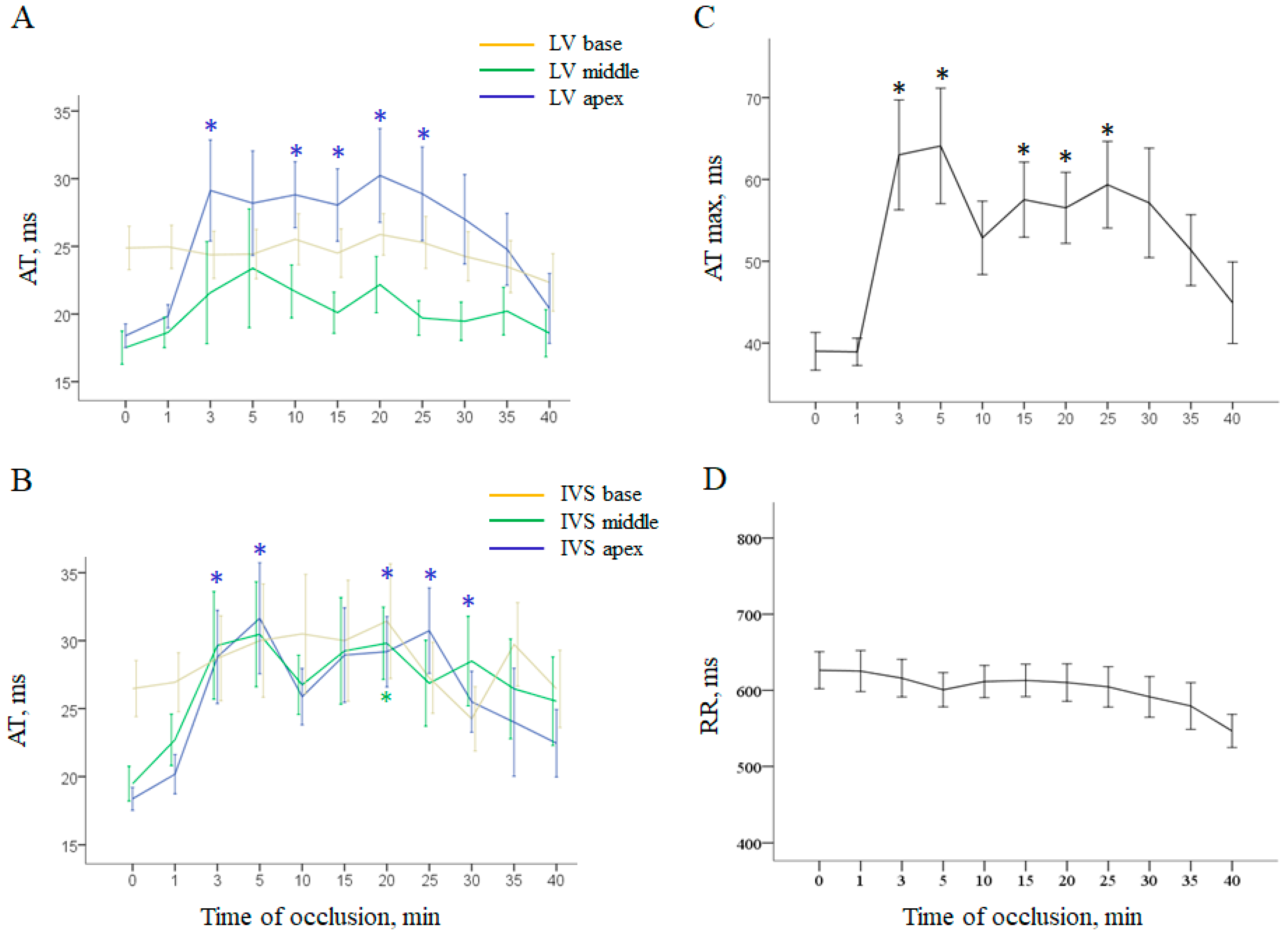
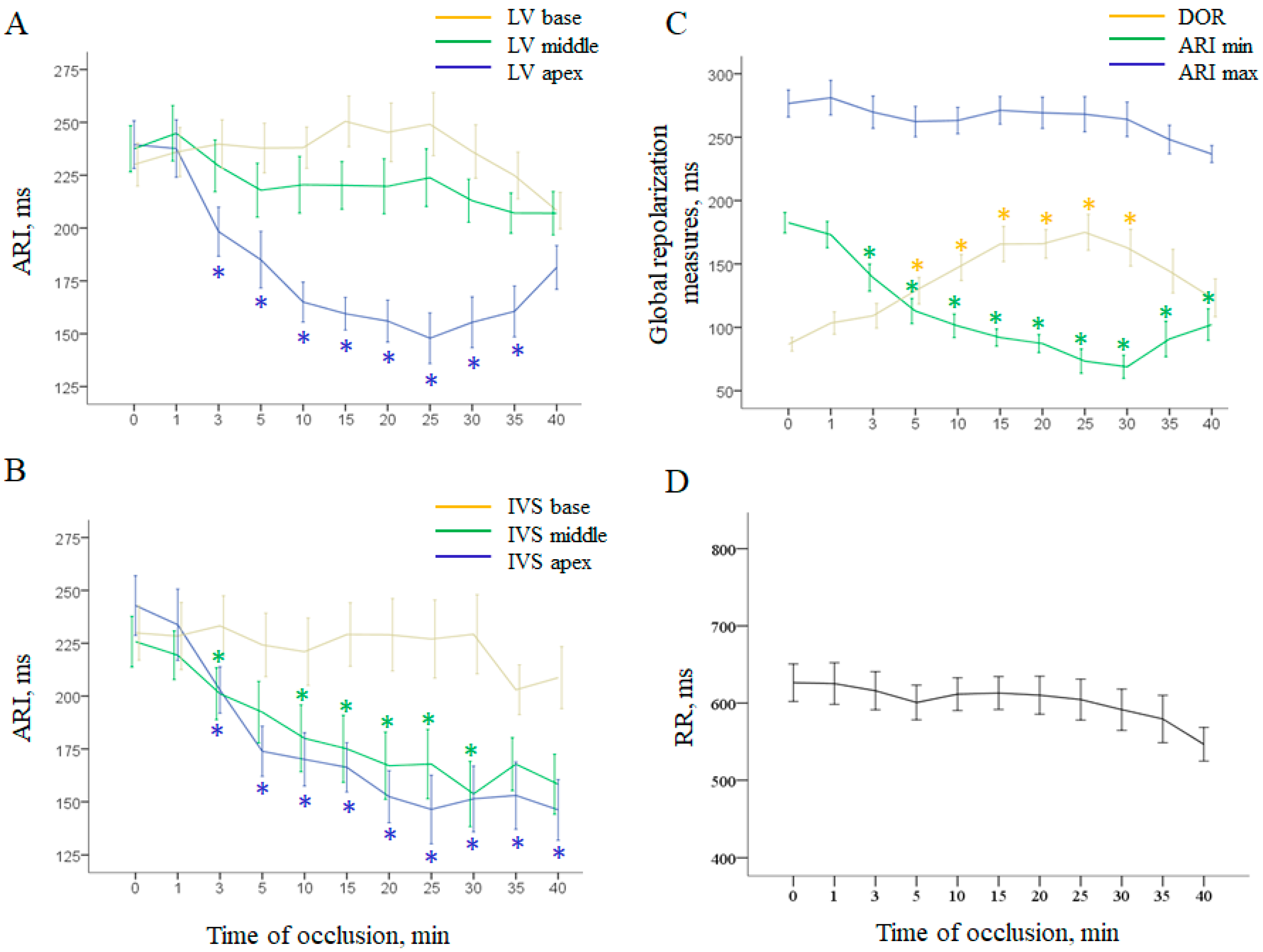

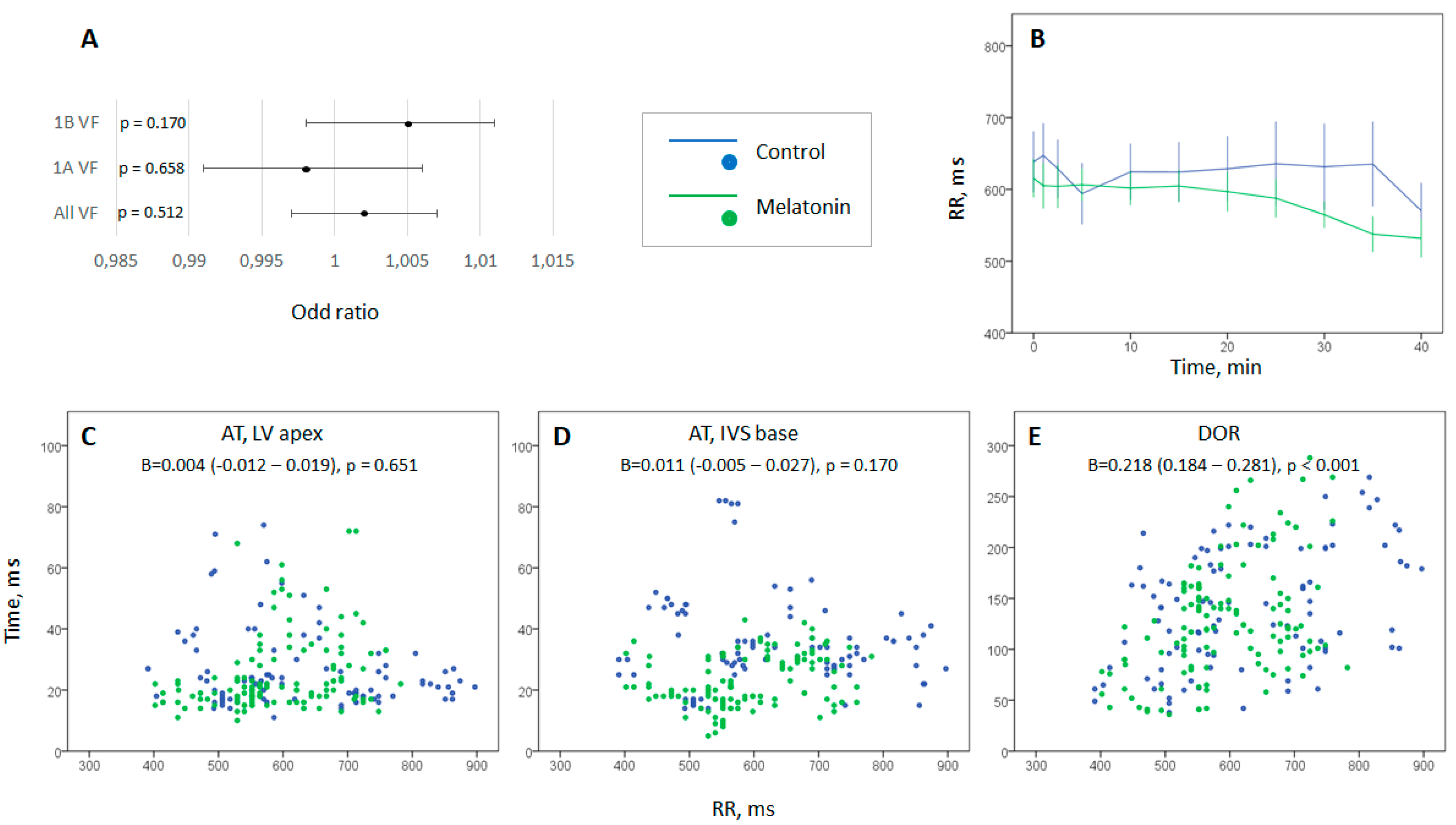
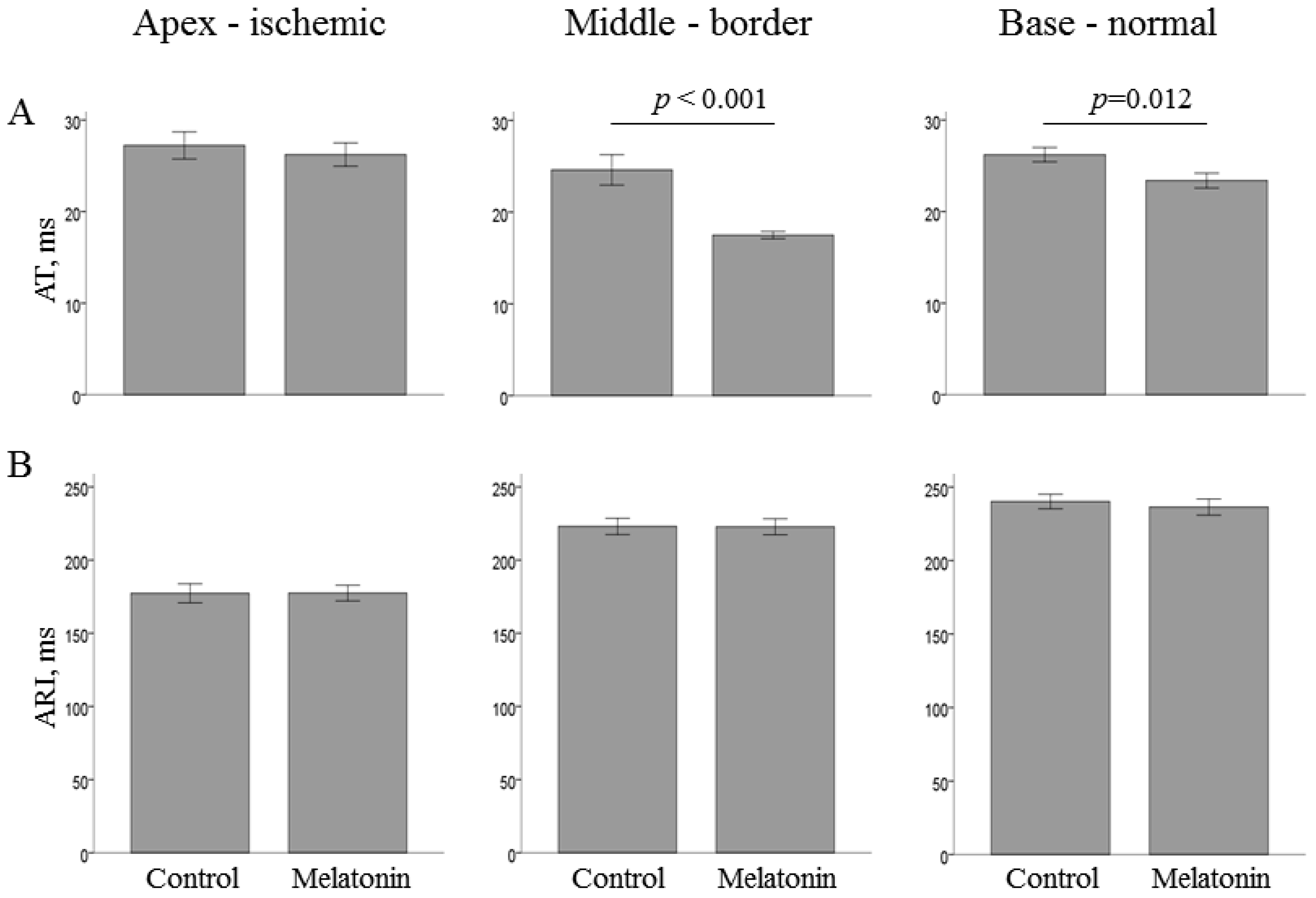
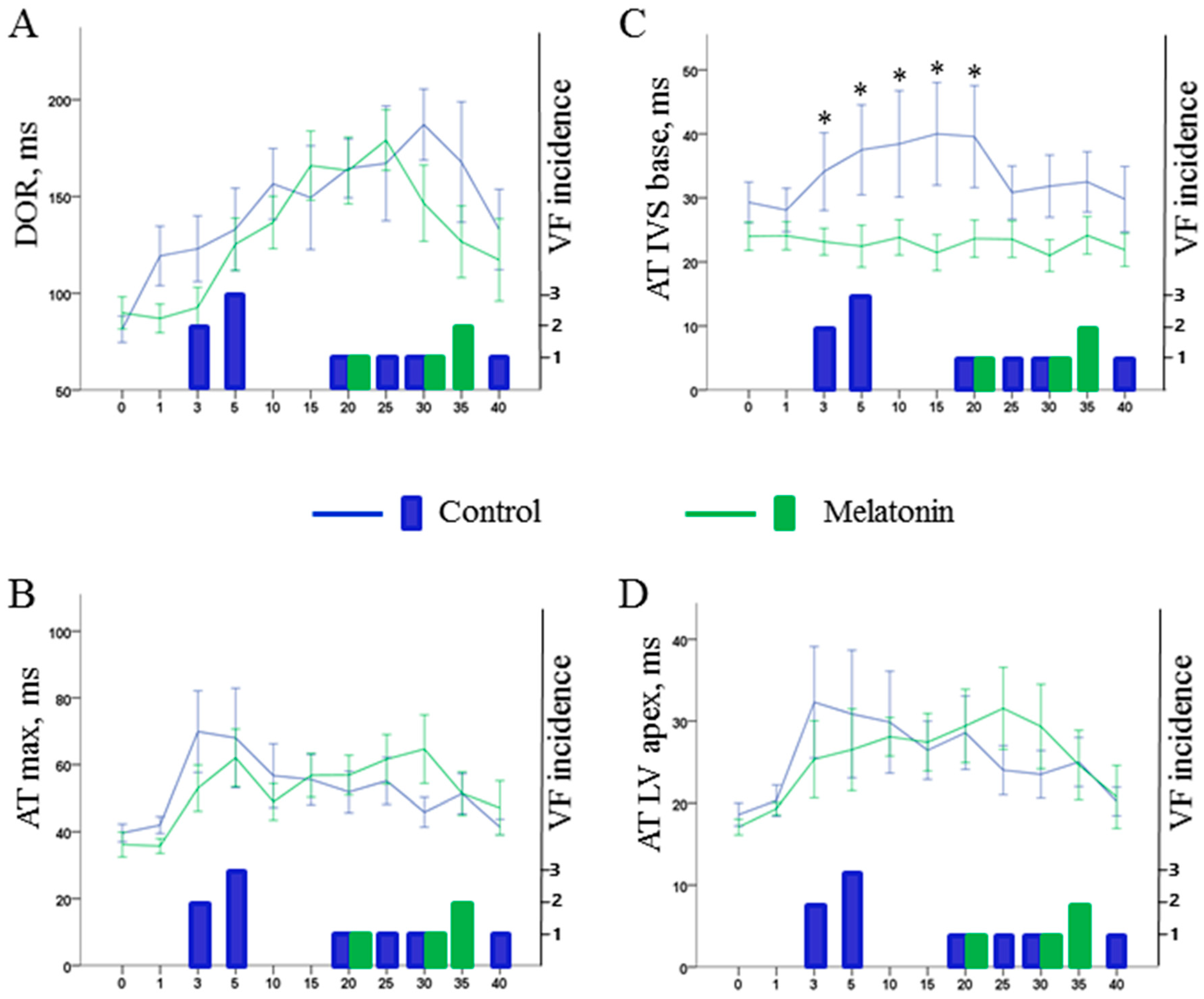

| Predictor (Activation) | OR (95% CI) | p | Predictor (Repolarization) | OR (95% CI) | p |
|---|---|---|---|---|---|
| AT LV apex | 1.058 (1.024–1.092) | 0.001 | ARI LV apex | 0.992 (0.981–1.003) | 0.136 |
| AT IVS apex | 1.017 (0.972–1.065) | 0.459 | ARI IVS apex | 0.999 (0.990–1.009) | 0.911 |
| AT LV middle | 1.006 (0.961–1.053) | 0.785 | ARI LV middle | 1.003 (0.993–1.013) | 0.511 |
| AT IVS middle | 1.023 (0.986–1.063) | 0.230 | ARI IVS middle | 1.001 (0.991–1.010) | 0.910 |
| AT LV base | 1.012 (0.945–1.085) | 0.727 | ARI LV base | 1.008 (0.998–1.018) | 0.100 |
| AT IVS base | 1.037 (1.003–1.072) | 0.031 | ARI IVS base | 1.005 (0.995–1.015) | 0.309 |
| AT max | 1.028 (1.010–1.047) | 0.003 | DOR | 1.015 (1.005–1.026) | 0.015 |
Publisher’s Note: MDPI stays neutral with regard to jurisdictional claims in published maps and institutional affiliations. |
© 2020 by the authors. Licensee MDPI, Basel, Switzerland. This article is an open access article distributed under the terms and conditions of the Creative Commons Attribution (CC BY) license (http://creativecommons.org/licenses/by/4.0/).
Share and Cite
Tsvetkova, A.S.; Bernikova, O.G.; Mikhaleva, N.J.; Khramova, D.S.; Ovechkin, A.O.; Demidova, M.M.; Platonov, P.G.; Azarov, J.E. Melatonin Prevents Early but Not Delayed Ventricular Fibrillation in the Experimental Porcine Model of Acute Ischemia. Int. J. Mol. Sci. 2021, 22, 328. https://doi.org/10.3390/ijms22010328
Tsvetkova AS, Bernikova OG, Mikhaleva NJ, Khramova DS, Ovechkin AO, Demidova MM, Platonov PG, Azarov JE. Melatonin Prevents Early but Not Delayed Ventricular Fibrillation in the Experimental Porcine Model of Acute Ischemia. International Journal of Molecular Sciences. 2021; 22(1):328. https://doi.org/10.3390/ijms22010328
Chicago/Turabian StyleTsvetkova, Alena S., Olesya G. Bernikova, Natalya J. Mikhaleva, Darya S. Khramova, Alexey O. Ovechkin, Marina M. Demidova, Pyotr G. Platonov, and Jan E. Azarov. 2021. "Melatonin Prevents Early but Not Delayed Ventricular Fibrillation in the Experimental Porcine Model of Acute Ischemia" International Journal of Molecular Sciences 22, no. 1: 328. https://doi.org/10.3390/ijms22010328
APA StyleTsvetkova, A. S., Bernikova, O. G., Mikhaleva, N. J., Khramova, D. S., Ovechkin, A. O., Demidova, M. M., Platonov, P. G., & Azarov, J. E. (2021). Melatonin Prevents Early but Not Delayed Ventricular Fibrillation in the Experimental Porcine Model of Acute Ischemia. International Journal of Molecular Sciences, 22(1), 328. https://doi.org/10.3390/ijms22010328





